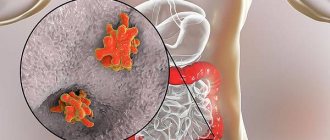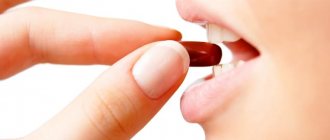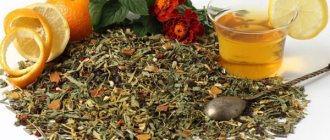Collection of gastrointestinal Fitogastrol N20 filter bags
Latin name
Phytogastrol
Active ingredient: Calamus rhizomes + Peppermint leaves + Chamomile flowers + Licorice roots + Dill fruits (Acori calami rhizomata + Menthae piperitae folia + Chamomillae recutitae flores + Glycyrrhizae radices + Anethi graveolentis fructus)
Compound
Each gram of the collection contains 200 mg of active ingredients: chamomile flowers, peppermint leaves, dill fruits, calamus rhizomes and licorice roots.
Release form
It is produced in the form of a herbal collection, which looks like small yellow-brown pieces of plant material interspersed with yellow, white, green or brown. Characterized by a strong aroma. The water extract is bittersweet.
The medicine is packaged in bags of 50 g or in small bags of 1.5 g. A bag of 50 g or 20 bags of 1.5 g is placed in a cardboard box.
Small bags contain plant raw materials, which are more crushed, almost to a powdery consistency.
pharmachologic effect
It is a herbal preparation that affects the digestive system. It has antispasmodic, anti-inflammatory, enveloping, choleretic effects and is able to correct the functioning of the gastric glands.
Pharmacodynamics and pharmacokinetics
Pharmacodynamics
The effect of Fitogastrol (gastrointestinal collection) on the human body is determined by the properties of the plants included in its composition:
peppermint leaves stimulate the secretion of gastric juice, increase the efficiency of the digestive process;
licorice root contains the substance glycerizin, which promotes the healing of ulcers and prevents their appearance;
chamomile flowers stimulate regeneration processes;
the fruits of dill contain a whole complex of biologically active substances (essential oil, flavonoids, carotene, phytoncides, sugars, vitamin C and others), which causes choleretic, antispasmodic, diuretic effects, helps cope with gas formation in the intestines, increases the secretory activity of the gastric glands;
a complex of biologically active substances contained in calamus rhizomes affects the endings of taste buds, causing an increase in appetite, improves the quality of the digestive process, enhances the reflex secretion of gastric juice, increases bile secretion, increases the tone of the gallbladder, and stimulates urination.
Pharmacokinetics
Not studied.
Indications for use
Gastric collection Fitogastrol is indicated for various diseases of the digestive tract, for example, colitis, gastritis, functional dyspepsia. Usually used in combination with other medications.
Contraindications
The use of Fitogastrol is contraindicated for:
hypersensitivity to one or more ingredients included in the collection;
calculous cholecystitis;
exacerbation of peptic ulcer of the stomach and duodenum;
treating patients under 12 years of age;
during pregnancy and lactation.
Side effects
Allergy symptoms may appear. In this case, you need to consult your doctor about how to take Fitogastrol in the future and whether it is worth doing.
Fitogastrol, instructions for use (Method and dosage)
A tablespoon of the collection is poured into an enamel or glass container, poured with a glass of boiling water, closed and kept in a boiling water bath for 15 minutes. Then cool for 45 minutes, filter and squeeze. Add water to the infusion so that its volume becomes 200 ml.
Place 2 bags in a glass or enamel bowl, add a glass of boiling water, leave for 15 minutes. Then the bags are squeezed out, and the volume of the solution is adjusted to 200 ml.
You need to drink half a glass half an hour before meals. The reception is repeated three times a day. The duration of the course of treatment is selected by the attending physician individually for each patient, as it depends on the nature of the disease.
Shake it well before drinking part of the solution. The prepared solution can only be stored in the refrigerator and for no longer than 2 days.
Overdose
There have been no reports of overdose.
Interaction
Not known.
Terms of sale
Over the counter.
Storage conditions
Must be stored in original packaging in a cool, dry place.
Best before date
2 years (dry collection), 2 days (prepared aqueous extract).
For children
Not used for treatment in patients under 12 years of age.
During pregnancy and lactation
It is not advisable to prescribe to pregnant and breastfeeding women, since clinical studies have not yet been conducted regarding the safety of the use of Fitogastrol for such categories of patients.
In the Russian Federation, the prevalence of cardiovascular diseases (CVD) has reached epidemic proportions. Patients with cardiac disorders predominate in appointments not only with general practitioners, but also with doctors of other specialties. Which patients from this group does the gastroenterologist think about? Of course, we are talking about those of them who take antiplatelet drugs and nonsteroidal anti-inflammatory drugs. According to modern recommendations, in order to prevent cardiovascular complications, patients with coronary heart disease (CHD) are advised to use antiplatelet drugs (aspirin, clopidogrel, ticlopidine) [1]. Meanwhile, to relieve pain caused by concomitant diseases (arthritis, musculoskeletal pathology, etc.), patients often uncontrollably take a wide variety of nonsteroidal anti-inflammatory drugs (NSAIDs).
Given the widespread prescription of antiplatelet drugs for long-term use, questions of the safety of this therapy become very relevant. The use of antiplatelet drugs and NSAIDs is associated with damage to the upper gastrointestinal (GI) mucosa, including erosive and ulcerative lesions, gastrointestinal bleeding and perforation [2, 3].
In people who regularly take NSAIDs, ulcerative lesions of the gastrointestinal tract occur in 25% of cases, and the incidence of bleeding and perforation is 2-4% [4, 5].
The incidence of major gastrointestinal bleeding with aspirin is 1.8 to 3.7%, and with dual antiplatelet therapy (aspirin and clopidogrel) from 3.0 to 4.9%, depending on the dose of aspirin (75-325 mg ) [6]. The development of upper gastrointestinal bleeding with low-dose aspirin is 0.5% per year (relative risk (RR) compared with placebo is 2.07; 95% CI 2.61-2.66) [7]. The risk of developing gastrointestinal bleeding increases sevenfold with the combination of clopidogrel and aspirin (odds ratio (OR): 7.4; 95% CI 3.5-15) compared with aspirin monotherapy [8].
Assessing the risk of adverse gastrointestinal effects of NSAIDs and antiplatelet drugs
Risk factors for the negative effects of antiplatelet agents and NSAIDs on the gastrointestinal tract are formulated in the recommendations given in the American College of Gastroenterology for the prevention of complications of gastropathy induced by NSAIDs. Gradations have been identified according to the degree of risk of negative effects of NSAIDs on the gastrointestinal tract: high, moderate and low risk [9]. In addition, the presence of Helicobacter pyloric infection is an independent and additional risk factor that must be considered separately (see table).
Based on these recommendations, many cardiac patients, even without a history of ulcers, are at high risk for developing gastrointestinal complications when taking NSAIDs and antiplatelet drugs.
NSAIDs and aspirin are most often taken by patients over 60 years of age, who, due to their age, immediately find themselves in a high-risk group. The increased incidence of gastrointestinal bleeding and perforation in old age compared to younger individuals is explained by an age-related decrease in endogenous prostaglandin synthesis. In addition, it has been proven that in old age the protective mechanisms of the gastroduodenal mucosa are directly affected: blood flow, mucin synthesis and bicarbonate secretion decrease. Older age negatively affects the course of peptic ulcer disease [10].
Moreover, most elderly patients are forced to take aspirin, clopidogrel, double and sometimes triple antiplatelet therapy (aspirin, clopidogrel, warfarin) for a long time. Concurrent use of NSAIDs is not uncommon.
Proton pump inhibitors: feasibility of prophylactic use
Clinicians must evaluate the risk/benefit ratio and balance between the beneficial effects of antiplatelet therapy in preventing cardiovascular events and adherence to the ancient medical principle of “do no harm.”
It is obvious that it is necessary to prevent NSAID gastropathy and gastrointestinal bleeding during antiplatelet therapy. An effective way to reduce the high risk of gastrointestinal complications caused by antiplatelet drugs may be the additional prescription of proton pump inhibitors (PPIs). According to international recommendations, PPIs are the drugs of choice for the treatment and prevention of NSAID-induced gastropathy and gastrointestinal lesions during antiplatelet therapy.
The effectiveness of this approach has been demonstrated in the treatment of NSAIDs, with aspirin monotherapy and with dual antiplatelet therapy with aspirin and clopidogrel.
Thus, the risk of gastric and duodenal ulcers induced by NSAIDs is reduced with the use of PPIs (OR 0.37; 95% CI 0.27-0.51) [11].
In a study by A. Lanas et al. [12] in 2777 patients with upper GI bleeding and 5532 controls, PPI use was associated with a reduced risk of bleeding for both low-dose aspirin users (OR 0.32; 95% CI 0.22–0.51) and and for those taking clopidogrel (OR 0.19; 95% CI 0.07-0.49).
In patients with coronary artery disease receiving dual antiplatelet therapy with aspirin and clopidogrel, prophylactic PPI administration reduces the incidence of upper gastrointestinal bleeding. These results were obtained in a large placebo-controlled randomized trial, COGENT, involving 3761 patients requiring long-term dual antiplatelet therapy (who had undergone acute coronary syndrome or coronary stenting) [13].
The addition of omeprazole at a dose of 20 mg per day to the combination of aspirin and clopidogrel was accompanied by a significant reduction in the risk of gastrointestinal bleeding by 45%. In the group of patients receiving PPIs, both any gastrointestinal disorders (RR=0.34; 95% CI 0.18-0.63; p<0.001) and overt bleeding from the upper gastrointestinal tract (RR=0) were less common. .13; 95% CI 0.03-0.56; p=0.001) compared with the placebo group. The COGENT trial demonstrated that the effectiveness of antiplatelet treatment was not reduced by the addition of a PPI. There was no statistically significant increase in the risk of cardiovascular events with the addition of PPIs to antiplatelet therapy. A total of 4.9% of patients in the PPI group and 5.7% of those in the placebo group experienced cardiovascular events (OR=0.99; 95% CI 0.68-1.44; p= 0.96). However, the reported results should be taken critically, since this study was terminated early for financial reasons.
Proton pump inhibitors when taking antiplatelet drugs: to whom and when?
Risk factors and comorbidities should be assessed when selecting patients for adjunctive PPI therapy (see table).
Age, use of warfarin, steroids, NSAIDs, or H. pylori infection increase the risk of gastrointestinal bleeding during antiplatelet therapy.
For clinical use, an algorithm has been developed to reduce the risk of negative effects of antiplatelet drugs on the gastrointestinal tract by using PPIs (see figure)
[14].
Figure 1. Patient selection algorithm for PPI therapy with concomitant antiplatelet treatment [14].
How to avoid drug interactions
Currently, the medical world is actively discussing the interaction and safety of combining clopidogrel with PPIs (especially with omeprazole), since PPIs have the potential to reduce the amount of the active metabolite of clopidogrel and the severity of its antiplatelet effect. Certain genetic polymorphisms and a high probability of drug interactions in the cytochrome P-450 system with the addition of PPIs can lead to changes in the antiplatelet effectiveness of clopidogrel PPIs [15].
Clopidogrel is a prodrug that is transformed into an active metabolite by the cytochrome P-450 system in the liver. The active metabolite of clopidogrel selectively and irreversibly blocks the binding of ADP to platelet receptors of the P2Y12 type, which in turn blocks their activation through the IIb/IIIa complex. Activation of clopidogrel occurs in two stages. Initially, it undergoes oxidative biotransformation in the liver with the participation of the isoenzymes CYP2C19, CYP1A2 and CYP2B6, turning into 2-oxo-clopidogrel. The second stage is the hydrolysis of 2-oxo-clopidogrel into the active metabolite of clopidogrel using isoenzymes CYP3A, CYP2B6, CYP2C9, CYP2C19.
The metabolism of clopidogrel and 2-oxo-clopidogrel is largely dependent on the induction or inhibition of CYP2C19, which is due to the influence of various drugs, as well as individual genetic polymorphisms [16].
The metabolism of PPIs, as well as clopidogrel, occurs in the cytochrome P-450 system, predominantly with the participation of CYP2C19 and to a lesser extent - CYP3A4.
The use of PPIs may inhibit the conversion of clopidogrel to its active metabolite through its effect on CYP2C19, leading to a weakening of its antiplatelet activity. The risk of drug failure increases when drug concentrations are dependent on variable activity of a single metabolic pathway. Such a high pharmacokinetic risk was found with clopidogrel [17].
Another explanation for the effect of PPIs on the activity of clopidogrel may be a change in intragastric pH during PPI administration, which changes the absorption of clopidogrel. PPIs block the proton pump of gastric parietal cells, and restoration of intragastric pH is possible only with the cessation of the long-term therapeutic effect of PPIs, after 12-24 hours.
In addition, pharmacokinetic and antiplatelet testing of the active metabolite of clopidogrel showed that the concentration and antiplatelet effects of the drug differ depending on the genetic polymorphism of the CYP2C19 enzyme. The CYP2C19*1 allele results in fully functioning clopidogrel metabolism. The CYP2C19*2 and *3 alleles do not effectively metabolize clopidogrel. Patients with two reduced activity alleles (homozygotes) exhibit slow metabolization of clopidogrel. Certain genetic polymorphisms can lead to a 50% increase in cardiovascular risk and a threefold increase in the risk of stent thrombosis in patients receiving clopidogrel [18].
Clinical effectiveness of combined use of proton pump inhibitors and clopidogrel
In December 2010, a consensus was published by the American College of Cardiology and the American College of Gastroenterology regarding the combined use of thienopyridines (clopidogrel, prasugrel) and PPIs, which covered in detail the issues of changes in the effectiveness of clopidogrel while taking PPIs [19]. The clinical trial results presented in these guidelines range from a statistically insignificant effect of PPIs on increasing the risk of cardiovascular events to a significant association between PPI use and cardiovascular risk.
In a retrospective cohort study, M. O'Donoghue et al. in 13,608 patients treated with clopidogrel or prasugrel after stenting, there was no effect of PPIs on increasing mortality due to cardiovascular disease, myocardial infarction or stroke (RR for clopidogrel 0.94; 95% CI 0.80-1.11) [20]. No differences were demonstrated between PPI types, including omeprazole (n=1675), lansoprazole (n=441), ezomprazole (n=613) and pantoprazole (n=1844). PPIs did not increase the incidence of cardiovascular events even in patients who were “poor metabolizers” who had reduced function of the CYP2C19 allele. In the CREDO (Clopidogrel for Reduction of Events During Observation) study, PPI use was associated with an increased incidence of cardiovascular events in both patients with and without clopidogrel use [21].
Only one randomized clinical trial, the above-mentioned COGENT trial, examined the relationship between clopidogrel and PPIs. It has been proven that PPIs have no effect on increasing cardiovascular risk with a parallel statistically significant reduction in the risk of gastrointestinal complications.
Possibilities of pantoprazole in the prevention of gastrointestinal complications against the background of antiplatelet drugs
To date, the latest recommendations (ACCF/ACG/AHA 2010 Expert Consensus Document on the Concomitant Use of Proton Pump Inhibitors and Thienopyridines) do not indicate the priority use of a particular PPI during antiplatelet therapy. A retrospective study (W. Ray, 2010) involving 20,596 patients did not show a significant effect of any of the PPIs used (esomeprazole, lansoprazole, omeprazole, rabeprazole, pantoprazole) on an increase in the frequency of cardiovascular episodes [22].
The latest meta-analysis by S. Shukla and S. Guba does not allow us to conclude that PPIs reduce the activity of clopidogrel. But still, simultaneously with clopidogrel, the authors recommend prescribing not omeprazole, but pantoprazole or rabeprazole, since the latter do not affect the cytochrome 2C19 system.
Based on knowledge of the pharmacokinetic properties of PPIs and their effect on the cytochrome P-450 system, we can talk about the advantages of prescribing pantoprazole (Controloc, Nycomed) to patients with cardiovascular pathology receiving antiplatelet drugs.
Pantoprazole has a lower affinity for the hepatic cytochrome P-450 system, does not affect its activity and does not produce clinically significant reactions with many drugs, including antiplatelet agents and NSAIDs. This significantly expands the scope of its application, since pantoprazole is more suitable for use in conjunction with other medications, allowing us to assume with greater confidence that their effect will not change in the direction of strengthening, weakening or perversion. As a result, the effect of other drugs metabolized with the participation of enzyme systems of this cytochrome is not weakened, which is especially important in elderly patients with cardiac problems who are forced to take several drugs at the same time.
Pantoprazole undergoes little first-pass metabolism and has a constant bioavailability after the first dose. Pantoprazole is the only PPI that binds to the proton pump cysteine at position 822. Cysteine 822 is thought to provide stability and long-lasting inhibition of the proton pump and acid production. Therefore, pantoprazole is characterized by a longer acid-lowering effect [23].
At a wider pH range, pantoprazole accumulates in parietal cells and interacts with the thiol group of the proton pump. Being a more stable compound, pantoprazole is less likely to react with thiol groups of proteins outside the parietal cell, which allows us to rely on its predicted pharmacokinetic properties [24].
If we talk about drug interactions between antiplatelet drugs and pantoprazole, then the latter has a low ability to enter into this drug-drug interaction. This is due to the lower affinity of pantoprazole compared to other PPIs for the CYP2C19 and CYP3A4 isoenzymes.
Unlike most products formed in phase I biotransformation of other PPIs, the initial metabolite of pantoprazole 4-hydroxypantoprazole, formed by the CYP system, very quickly leaves the cytochrome P-450 system, as a result of which the possibility of competition with various drugs at the level of CYP isoenzymes is eliminated. 4-hydroxypantoprazole is then biotransformed secondarily (phase II) through conjugation with sulfate in the cytosol. This conjugation reaction is often considered to be the reason for pantoprazole's lower ability to engage in drug-drug interactions.
If we talk about pantoprazole drugs, the leading drug is the original pantoprazole - Controloc (Nycomed). The molecule of the original pantoprazole has a unique double shell, which protects the active substance from the aggressive acidic environment of the stomach and allows it to be absorbed in the intestines. Controloc has such properties as irreversible and complete blockade of proton pumps, linear bioavailability (the same for each day of therapy), independence from food intake, and compatibility with other drugs, including antiplatelet drugs. Thus, Controloc (Nycomed) is a priority drug for additional use in cardiac patients with cardiac problems at risk of developing gastrointestinal complications who are forced to take antiplatelet drugs. This is due to minimal drug-drug interactions, the influence of pantoprazole on the cytochrome P-450 system and a long-lasting, sustained acid-lowering effect.
Conclusion
The need for long-term use of antiplatelet drugs is associated with an increased risk of developing gastrointestinal tract damage. Additional prophylactic use of PPIs significantly reduces the risk of gastrointestinal bleeding, but raises conflicting opinions regarding the weakening of antiplatelet effectiveness and the problem of drug interactions. Metabolism of both PPIs and antiplatelet agents by CYP isoenzymes of the hepatic cytochrome P-450 system, as well as individual genetic polymorphism, determine the effectiveness and safety of this combination. Among PPIs, the original drug pantoprazole (Controloc, Nycomed) has the least potential for drug-drug interactions and can serve as the drug of choice when prescribed to cardiac patients with a high risk of developing gastrointestinal complications who are forced to constantly receive antiplatelet therapy.
Release form
It is produced in the form of a herbal collection, which looks like small yellow-brown pieces of plant material interspersed with yellow, white, green or brown. Characterized by a strong aroma. The water extract is bittersweet.
The medicine is packaged in bags of 50 g or in small bags of 1.5 g. A bag of 50 g or 20 bags of 1.5 g is placed in a cardboard box.
Small bags contain plant raw materials, which are more crushed, almost to a powdery consistency.
Fitogastrol price, where to buy
Fitogastrol can be bought for about 75 rubles in Russian pharmacies or for 25 hryvnia in Ukrainian pharmacies.
- Online pharmacies in RussiaRussia
- Online pharmacies in UkraineUkraine
ZdravCity
- Fitogastrol (Gastrointestinal collection) 2g filter pack.
20pcs JSC Krasnogorskleksredstva 101 rub.order
Pharmacy Dialogue
- Phytogastrol collection (Gastrointestinal) (form 2g No. 20) Krasnogorskleksredstva
92 rub. order
- Phytogastrol collection (Gastrointestinal) (50g) Krasnogorskleksredstva
75 rub. order
show more
Pharmacy24
- Phytogastrol collection 1.5 g in sachets No. 20 PrAT "Liktravi", m.
Zhytomyr, Ukraine 33 UAH. order
Analogs
Level 4 ATX code matches: Verona
Phibs
Gastrikumel
Thyroidea Compositum
Berlition
Thiolepta
Gastric collection
Espa-Lipon
Brewer's yeast
Lipoic acid
Rosehip syrup
Octolipen
Thioctacid
Thiogamma
Figurin
Analogues of Fitogastrol:
- Actovegin;
- Aloe juice;
- Aloe Extract.
What may be useful
Products approved for use that cause adequate secretion include:
- fermented baked milk, low-fat kefir, homemade yogurt;
- vegetable soups with a weak broth;
- boiled fish and lean meat (dietary beef, rabbit, chicken and turkey);
- boiled vegetables such as carrots, zucchini, cauliflower, etc.;
- steam omelettes, egg whites;
- dried bread made from premium flour, etc.
It is also important to take into account the mechanical effect on the stomach, so it is better to give preference to pureed, well-cooked, liquid, and porridge-like dishes. Such food is easier to absorb and digest without burdening the gastrointestinal tract. As an additional source of nutrients, as well as as a replacement for one of the meals, you can include special liquid mixtures in your diet. For example, Nutrien® Standard is suitable for self-use during the treatment of gastrointestinal diseases. This mixture is already fully balanced in nutrients and has an easily digestible consistency.
Fitogastrol, instructions for use (Method and dosage)
A tablespoon of the collection is poured into an enamel or glass container, poured with a glass of boiling water, closed and kept in a boiling water bath for 15 minutes. Then cool for 45 minutes, filter and squeeze. Add water to the infusion so that its volume becomes 200 ml.
Place 2 bags in a glass or enamel bowl, add a glass of boiling water, leave for 15 minutes. Then the bags are squeezed out, and the volume of the solution is adjusted to 200 ml.
You need to drink half a glass half an hour before meals. The reception is repeated three times a day. The duration of the course of treatment is selected by the attending physician individually for each patient, as it depends on the nature of the disease.
Shake it well before drinking part of the solution. The prepared solution can only be stored in the refrigerator and for no longer than 2 days.
What is recommended to avoid?
Many diseases of the gastrointestinal tract entail disturbances in the digestion, absorption and assimilation of incoming food, therefore, when drawing up a therapeutic diet, it is necessary to take these features into account. In particular, it is necessary to exclude products that cause increased secretion of gastric juice and strongly irritate the mucous membranes of the gastrointestinal tract. These include:
- smoked meats;
- fatty meats (pork), lard;
- various sauces, marinades;
- nuts, legumes, coffee, old cheeses, flour products, carbonated drinks, chocolate, cranberries, blueberries, prunes, etc.
It is important to note that any therapeutic diet completely excludes alcohol and tobacco.





